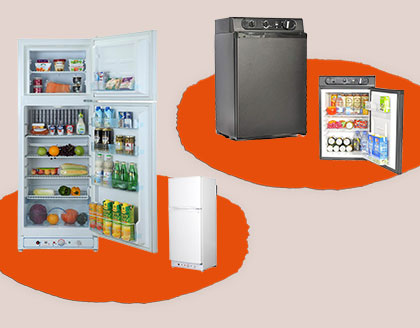Oct. 19, 2023 / Industry News
An absorption refrigerator is a type of refrigerator that uses a heat source
to provide the energy needed to drive the cooling process. Unlike the more
common compressor refrigerators that rely on electricity, an absorption
refrigerator can run on various sources of heat, such as solar energy, burning a
fossil fuel, waste heat from factories, or district heating systems. This
makes them suitable for applications where electricity is unreliable, costly, or
unavailable, or where noise from the compressor is problematic.
The global market for absorption refrigerators is expected to grow at a
compound annual growth rate (CAGR) of 3.1% from 2023 to 2030, reaching USD 473.2
million by 2030. The major factors driving the market growth are the increasing
demand for energy-efficient and silent cooling appliances, the rising adoption
of smart minibar refrigerators in the hospitality sector, and the expanding
commercial spaces that require compact and portable refrigeration solutions.
However, an absorption refrigerator also has some disadvantages, such as
lower efficiency, higher initial cost, and limited cooling capacity compared to
compressor refrigerators234. In this article, we will explore the different
types of absorption refrigerators, the factors that affect their performance and
efficiency, and some tips and best practices for distributing them.
In this article, we will explore the different types of absorption
refrigerators, the factors that affect their performance and efficiency, and
some tips and best practices for distributing them.

There are two main types of absorption refrigerators: 2-way and
3-way.
A 2-way absorption refrigerator can run on either propane (LP) gas or 120V AC
power (when plugged into shore power or running off a generator). A 2-way fridge
has a single electric heating element that can be powered by either source.
A 3-way absorption refrigerator can run on propane (LP) gas, 12V battery
power (most often only when the RV’s engine and alternator are supplying power),
or 120V AC power (when plugged into shore power or running off a generator). A
3-way fridge has two electric heating elements, one for 12V and one for 120V, in
addition to the propane burner.
The main difference between the two types is the flexibility and reliability
of the power sources. A 2-way fridge can operate in most situations where
electricity is available, but it may not work well in cold weather or at high
altitudes2 A 3-way fridge can operate in more situations where electricity is
unreliable, costly, or unavailable, but it may drain the battery quickly if used
on 12V mode.
There are several factors that affect the performance and efficiency
of absorption refrigerators, such as ambient temperature, ventilation, leveling,
and maintenance.
Ambient temperature: The ambient temperature is the
temperature of the air surrounding the refrigerator. It affects the heat
transfer between the refrigerator and the environment. A higher ambient
temperature reduces the cooling capacity and increases the energy consumption of
the absorption refrigerator.
Ventilation: Ventilation is the process of providing fresh
air to the refrigerator and removing the hot air from the thermal pump. It
affects the heat dissipation and the combustion efficiency of the propane
burner. A poor ventilation reduces the cooling capacity and increases the energy
consumption of the absorption refrigerator.
Leveling: Leveling is the process of adjusting the position
of the refrigerator to make it horizontal. It affects the circulation of the
working fluids in the cycle. A tilted refrigerator may cause poor performance,
noise, or damage to the system.
Maintenance: Maintenance is the process of inspecting,
cleaning, and repairing the refrigerator components. It affects the reliability
and durability of the system. A neglected refrigerator may cause reduced
performance, increased energy consumption, or malfunction.
In this section, we have discussed the basic principles and types of
absorption refrigerators, and how ambient temperature, ventilation, leveling,
and maintenance affect their performance and efficiency. These factors are
important to consider when distributing absorption refrigerators, as they can
influence the customer satisfaction and the environmental impact of the product.
In the next section, we will provide some tips and best practices for
distributing absorption refrigerators, such as how to choose the right size,
model, and location for the fridge, how to ensure proper installation and
operation, and how to comply with safety and environmental regulations.
1. Educate your customers about the benefits and drawbacks of absorption
refrigerators compared to compressor refrigerators, such as the lower noise,
higher flexibility, lower efficiency, and higher cost.
Help your customers choose the right type, size, and model of absorption
refrigerator according to their needs and preferences, such as the power source,
the cooling capacity, the design, and the features.
2. Provide proper installation and operation instructions for your customers,
such as how to level the refrigerator, how to ventilate the thermal pump, how to
adjust the temperature control, and how to switch the power source.
3. Offer regular maintenance and repair services for your customers, such as
how to clean the refrigerator, how to defrost the freezer, how to check the
connections and seals, and how to troubleshoot common problems.
4. Comply with safety and environmental regulations when distributing
absorption refrigerators, such as how to handle ammonia as a refrigerant, how to
dispose waste and recycle materials, and how to prevent carbon monoxide
poisoning.

If you are looking for a reliable and professional supplier of absorption
refrigerators, you may want to consider smad electric appliances. Smad is a
leading brand of home electric appliances with over 20 years of manufacturing
experience, which offers a wide range of absorption refrigerators, such as 2-way
or 3-way, with various sizes, models, and features to meet your customers’ needs
and preferences. Smad also provides high quality products with competitive
prices and fast delivery thanks to its overseas warehouses. Smad has obtained
many certificates and exported its products to more than 100 countries. Smad can
help you distribute absorption refrigerators with ease and efficiency, and help
you make money in the long run. You can visit the website here to learn more
about their products and services.


